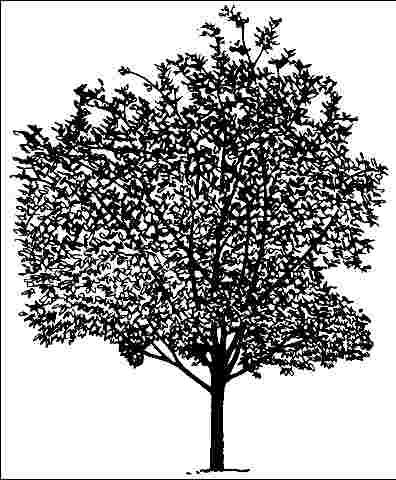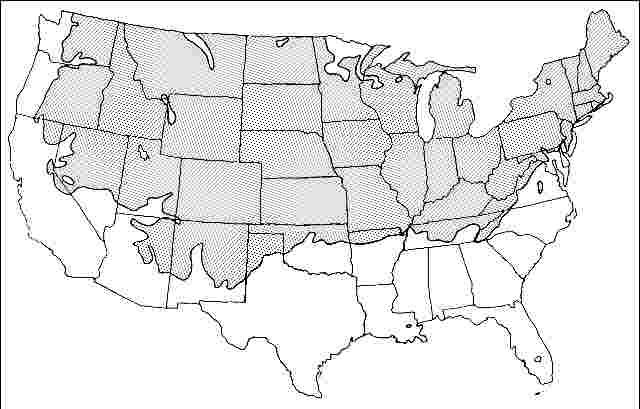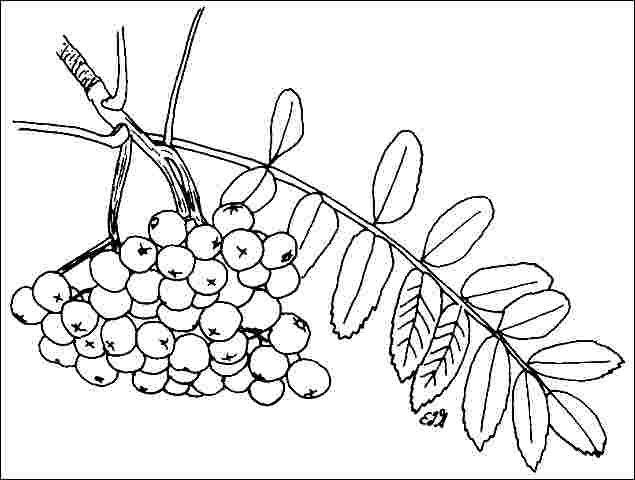Introduction
European mountain ash has a rapid growth rate at first but slows down with age, ultimately forming a 30-foot-tall, dense oval. The white flowers are somewhat showy, appearing in the spring after the leaves. The tree shows its true colors when the fruit is set in mid-summer. The wonderfully-showy, orange-red fruit is borne in heavy clusters of about 40 berries although cultivars are available with pink, yellow, and red fruits. Fruits are usually eaten by birds and often don't persist on the tree into the winter. Seeds germinate quite readily in the landscape. The fall color is red to yellow, although sometimes leaves simply drop green.

General Information
Scientific name: Sorbus aucuparia
Pronunciation: SOR-bus aw-kew-PAIR-ee-uh
Common name(s): European mountain ash
Family: Rosaceae
USDA hardiness zones: 3B through 6B (Fig. 2)
Origin: not native to North America
Invasive potential: little invasive potential
Uses: tree lawn 3-4 feet wide; tree lawn 4-6 feet wide; tree lawn > 6 ft wide; street without sidewalk; urban tolerant; specimen
Availability: somewhat available, may have to go out of the region to find the tree

Description
Height: 25 to 30 feet
Spread: 15 to 25 feet
Crown uniformity: symmetrical
Crown shape: oval, upright/erect
Crown density: moderate
Growth rate: moderate
Texture: fine
Foliage
Leaf arrangement: alternate (Fig. 3)
Leaf type: odd-pinnately compound
Leaf margin: serrate
Leaf shape: oblong, lanceolate, elliptic (oval)
Leaf venation: pinnate
Leaf type and persistence: deciduous
Leaf blade length: less than 2 inches
Leaf color: green
Fall color: yellow, red
Fall characteristic: showy

Flower
Flower color: white/cream/gray
Flower characteristics: showy
Fruit
Fruit shape: round
Fruit length: less than .5 inch
Fruit covering: fleshy
Fruit color: red, orange, yellow
Fruit characteristics: attracts birds; showy; fruit/leaves a litter problem
Trunk and Branches
Trunk/bark/branches: branches don't droop; not showy; typically multi-trunked; thorns
Pruning requirement: needed for strong structure
Breakage: susceptible to breakage
Current year twig color: brown
Current year twig thickness: medium
Wood specific gravity: unknown
Culture
Light requirement: full sun
Soil tolerances: clay; sand; loam; acidic; well-drained
Drought tolerance: moderate
Aerosol salt tolerance: moderate
Other
Roots: not a problem
Winter interest: yes
Outstanding tree: yes
Ozone sensitivity: sensitive
Verticillium wilt susceptibility: resistant
Pest resistance: sensitive to pests/diseases
Use and Management
Vertically-oriented branches and multiple trunks make this deciduous tree particularly attractive during the winter. But this same characteristic can also cause branches to break from the trunk due to poor connections with the trunk. The tree is restricted to northern areas due to lack of heat tolerance. It is a tough, urban tolerant tree but is susceptible to several pests including fire blight which can disfigure or kill the tree.
Several cultivars make excellent street trees.
Cultivars are: 'Asplenifolia'—leaflets doubly serrated; 'Apricot Queen'—apricot colored fruits; 'Beissneri'—deeply cut leaflets, red branchlets; 'Brilliant Pink'—pink fruits; 'Cardinal'—clear red fruits; 'Carpet of Gold'—yellow fruit; 'Cole's Columnar'—upright growth habit; 'Fastigiata'—upright growth habit; 'Kirsten Pink'—pink fruit; 'Maidenblush'—fruits white flushed with pink; 'Pendula'—weeping growth habit; 'Rowencroft Pink Coral'—coral pink fruits; 'Red Strain'—fruits red; 'Scarlet King'—fruits scarlet; 'Upright Yellow'—upright growth habit, yellow fruits; 'Wilson's Columnar'—upright growth; 'Xanthocarpa'—yellow fruit, not attractive to birds.
Pests
Aphids cause distorted growth and deposits of honeydew on leaves.
Mountain ash sawfly larvae are light green with black dots and tend to feed in groups. The insects curl the back of their bodies around the stems as they feed.
Scales of various types can usually be controlled with sprays of horticultural oil.
Diseases
Bacterial fire blight causes leaves at the branch tips to wilt, turn brown, but remain hanging on the tree. The infected branches have a scorched appearance and infected bark discolors, shrivels and may crack or be shredded. There is usually a crack between diseased and healthy bark. The bacteria are washed down the branches and onto the trunk by rain. Once the trunk is girdled the tree dies. Prune out infected branches. Use of high nitrogen fertilizers can increase susceptibility to fire blight.
Scab can cause severe defoliation. Early in the growing season, olive brown spots form along the mid-ribs of the leaflets. Later the leaves turn yellow and the spots become more prominent. If the infection is severe, infected leaves drop.
Several fungi cause twig and trunk cankers. As cankers enlarge the part of the stem beyond the canker dies. Avoid wounding trees and keep them healthy with regular fertilization.
Powdery mildew forms a white coating on the leaves.
Several rust diseases cause raised, light yellow spots on the leaves. Later, orange fruiting bodies appear on the spots on the lower leaf surface.